The evolution of home 3d printer manufacturing
I was prompted to write a publication by correspondence with a friend from my city. Its essence is as follows: he advises another to assemble a printer according to his scheme, and not so long ago I disassembled my first Mendel 90 3d printer.
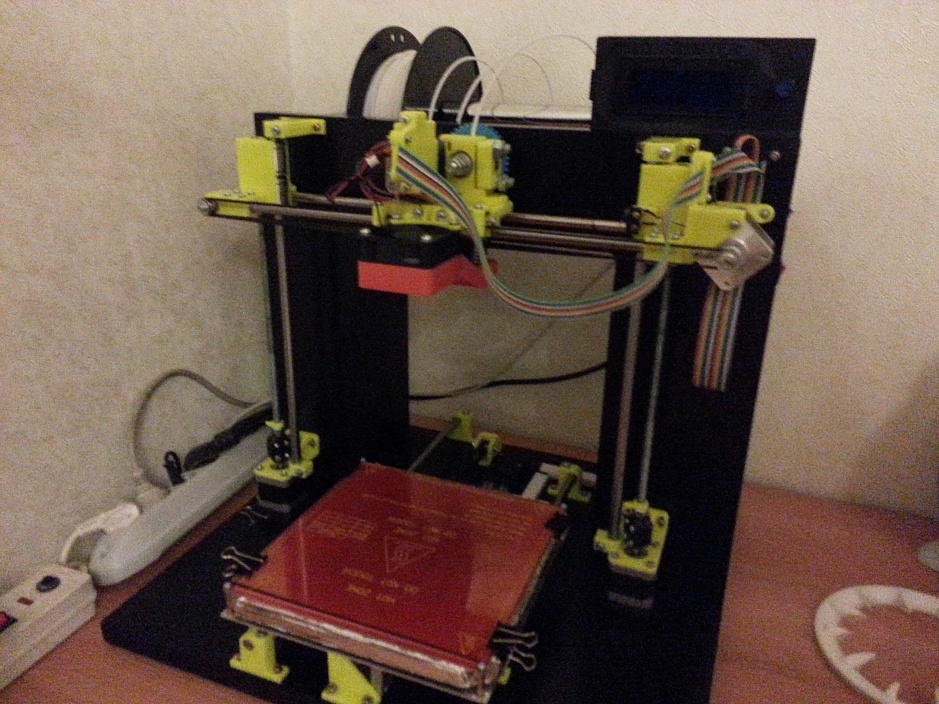
This was my first printer, and he introduced me to the amazing world of 3d printing. More than a year has passed since that moment, but I do not regret my choice at all, although there were enough unpleasant moments, a lot of nerves have been spent from misunderstanding the ongoing process and the problems that arise. I bought this printer from a person in my city for 43 thousand rubles, compared to what official representatives on the market (at the moment, prices are only creeping up) for 100 thousand, and I obviously did not intend to spend that amount on an unknown toy, then this printer looked quite normal to itself: there was a table heating, printing from an SD card, nozzles of different calibers, simplicity of design ... But there were also drawbacks, because of which I dismantled it a year later. Over time, I began to understand the flaw of this layout:
The war and peace with the printer lasted about 8-9 months, until I realized that I wanted a printer with a somewhat large print area and a closed thermal camera, so that parts from ABS plastic could be printed without any problems. There was no talk of assembling this for very objective reasons, so the choice was literally from one option: The
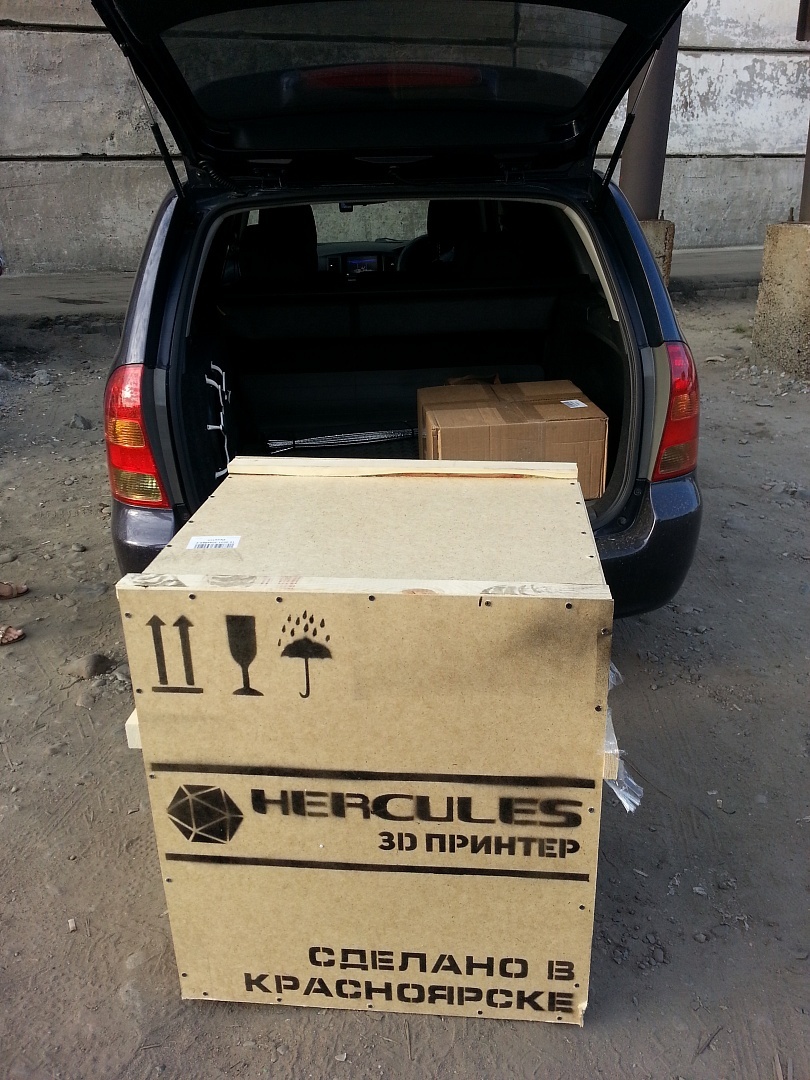
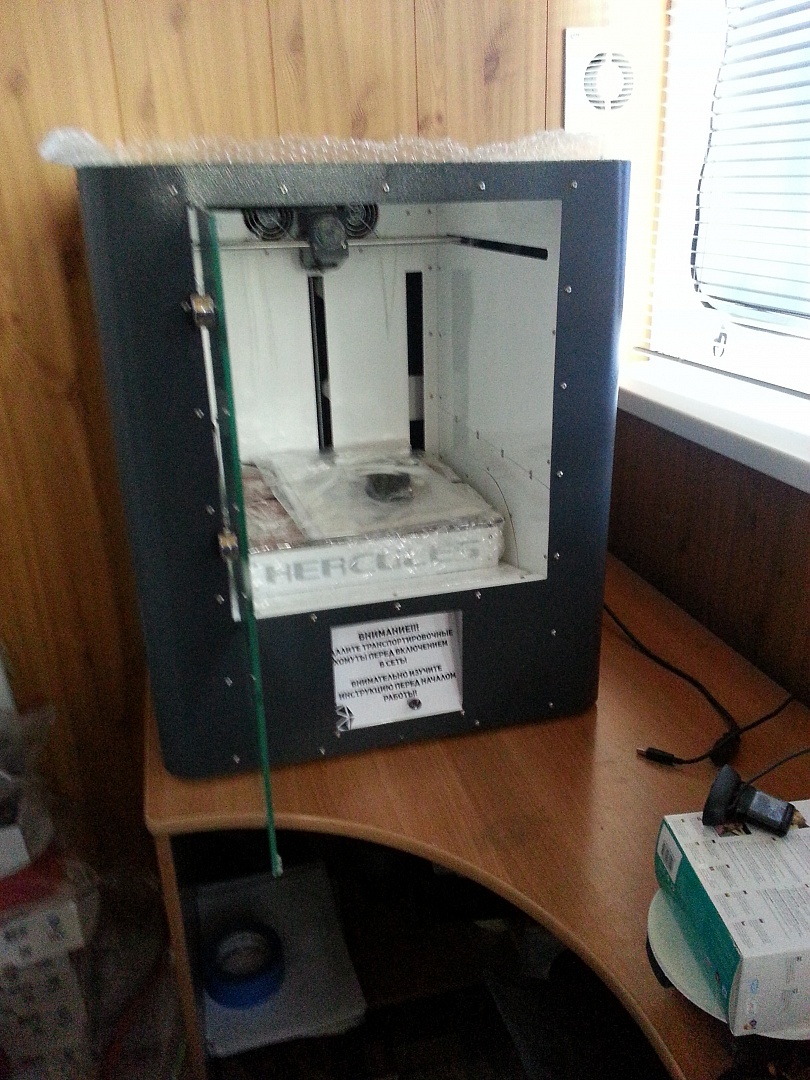
impressive print area of 30x30x40 cm was amazing, the closed thermal chamber promised new opportunities! This unit for 125 thousand and 10 kg of plastic as a gift, of course, also revealed its shortcomings, but, I repeat, there was no choice, there was only one such printer and there were no competitors at that time, and now something is not very visible ...
When the second printer appeared, I began to think hard about remaking the first one, since I was tired of it with my whims. I considered various options, I didn’t have time to do the housing myself, I didn’t want to buy dubious quality from Ultimaker 2 from the Chinese for 25 thousand, and finally I came across an article about a printer on rails with a compact housing (I won’t give a direct link, so I don’t sell them and don’t want to do advertising with a pronounced character) and for a little money 6200 rubles along with delivery. I wrote to the seller, discussed the details, ordered the rails and parts that weren’t enough (which Mendel didn’t match or didn’t have) and waited. By the time this miracle came:
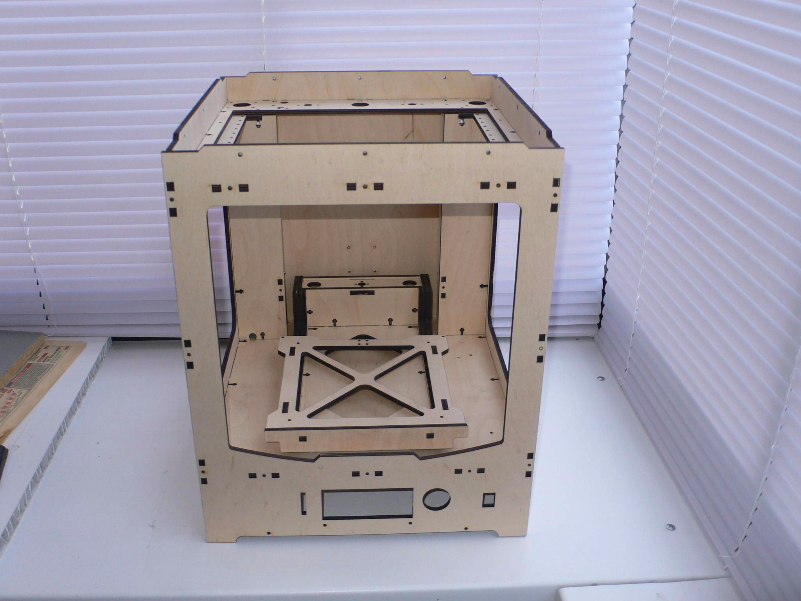
All parts were in stock, Mendel was mercilessly dismantled and put into other good hands, and I started assembling my first printer.
For my 28 years, I already forgot how to experience such puppy delight and enthusiasm, I collected it at work and sometimes scored it specifically, but I walked stubbornly towards the goal. After 2-3 weeks, the printer was 95% ready, it remains to wait for the second fan to blow and the rest is in the details, which clearly did not affect the work:
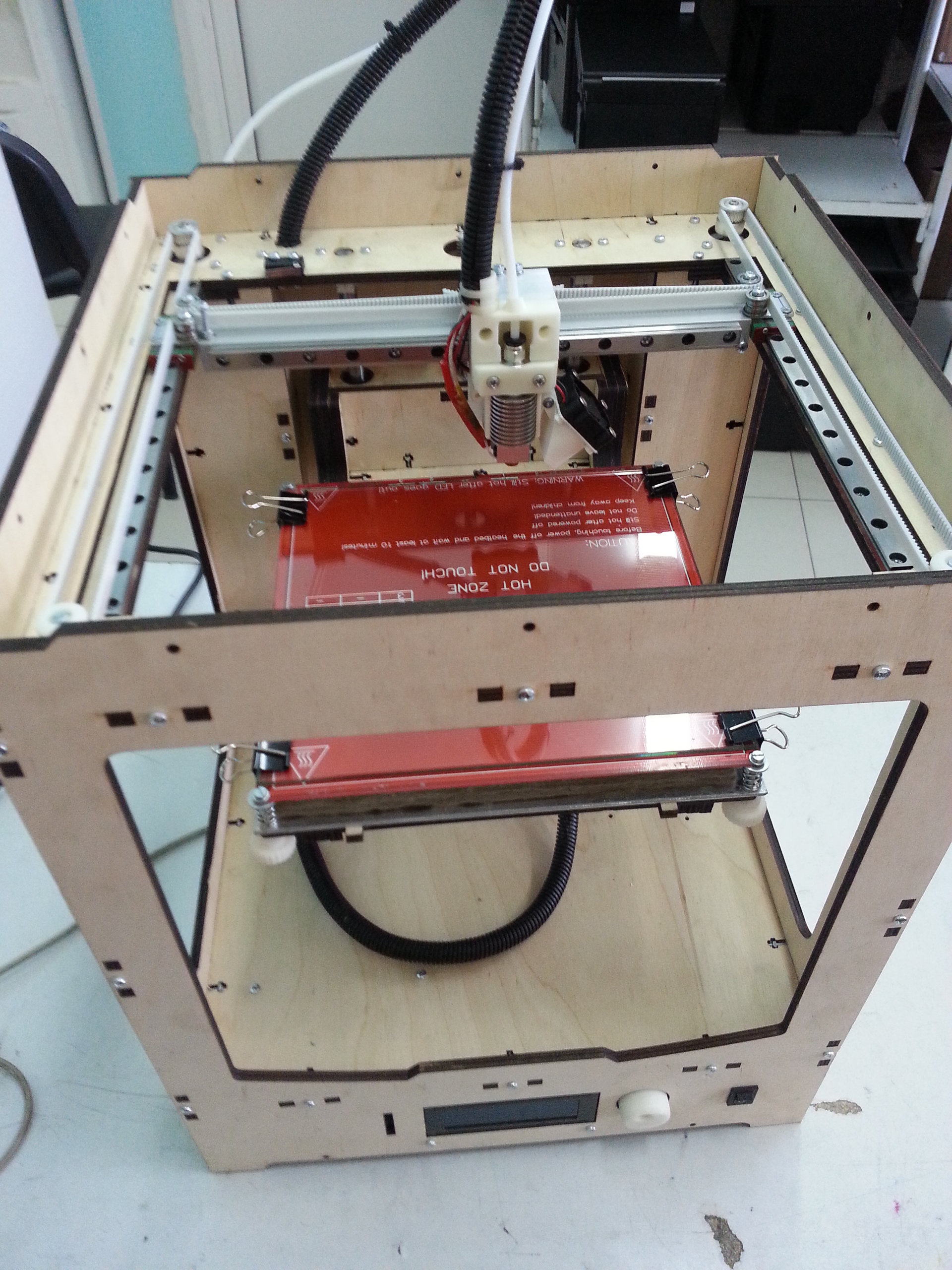
And now back to where I started. My acquaintance advises another acquaintance to assemble Mendel according to his scheme, they say it’s budgetary and for the first time it’s off, but I can’t understand one thing, why people assemble deliberately flawed assemblies when new designs appear on the market, as they say, there’s no reason to compare completely correct, but still give a brief description of the printer that was built:
Now about the cost, I recently ordered spare parts for the second such printer, for everything about everything, together with the case I got into 25 thousand rubles, the most expensive is:
So, here I can’t understand why people themselves are looking for difficulties with manufacturing structures that are already outdated and questionable from a technical point of view, when it’s worth adding a few thousand and getting an apparatus that will be much better and more reliable. Let it take a little longer to build and a little more cost, but it will be worth it. I think that it makes no sense to give examples of factory printers (although there are not many), which cost from 150 thousand. Modern technologies allow you to calmly and effortlessly (if you have direct hands) assemble a 3d printer that will not be inferior to the "factory" counterparts, but in some way surpass them.
If there is interest among readers of this post, then I can lay out the assembly process, as well as a list of spare parts for this assembly. I don’t sell these cases, I know at least two people who cut and sell them, therefore there is no advertising, but I only give reason to think well if you decide to assemble your first printer. There are also no examples of printing, since the post is not about that.
Thank you all for your attention, all good!
Here is a video of the printing process at a speed of 200 mm / sec.
By popular demand, I begin the series of articles “25 thousand for a printer on rails”

This was my first printer, and he introduced me to the amazing world of 3d printing. More than a year has passed since that moment, but I do not regret my choice at all, although there were enough unpleasant moments, a lot of nerves have been spent from misunderstanding the ongoing process and the problems that arise. I bought this printer from a person in my city for 43 thousand rubles, compared to what official representatives on the market (at the moment, prices are only creeping up) for 100 thousand, and I obviously did not intend to spend that amount on an unknown toy, then this printer looked quite normal to itself: there was a table heating, printing from an SD card, nozzles of different calibers, simplicity of design ... But there were also drawbacks, because of which I dismantled it a year later. Over time, I began to understand the flaw of this layout:
- A rigidly fixed table without the possibility of fine calibration in the form of springs and bolts, everything was twisted rigidly;
- From the previous paragraph, the following climbs out - it is required to strictly observe the horizontal axis of the Z axis, if there is a difference of 200-300 microns in height at different angles, everything is useless, the first layer simply will not lie down normally;
- The design itself, which involves the simultaneous movement of the table back and forth along the Y axis and the X axis itself, which moves at the same time perpendicular to the Y axis, looks magical from the side, but in practice this leads to unnecessary vibrations of the model on the table, and if you do if something is tall and small in size at the base, there is a great risk that the model will simply fall (which sometimes happened);
- Slow printing, it makes no sense to disperse a heavy carriage with an extruder and motor over 60 mm / s - there will be artifacts and other delights;
- Large sizes with a standard print area of 20x20x20 cm, everything is placed extremely compact;
- The list goes on, but there will be relatively minor printer flaws there ...
The war and peace with the printer lasted about 8-9 months, until I realized that I wanted a printer with a somewhat large print area and a closed thermal camera, so that parts from ABS plastic could be printed without any problems. There was no talk of assembling this for very objective reasons, so the choice was literally from one option: The


impressive print area of 30x30x40 cm was amazing, the closed thermal chamber promised new opportunities! This unit for 125 thousand and 10 kg of plastic as a gift, of course, also revealed its shortcomings, but, I repeat, there was no choice, there was only one such printer and there were no competitors at that time, and now something is not very visible ...
When the second printer appeared, I began to think hard about remaking the first one, since I was tired of it with my whims. I considered various options, I didn’t have time to do the housing myself, I didn’t want to buy dubious quality from Ultimaker 2 from the Chinese for 25 thousand, and finally I came across an article about a printer on rails with a compact housing (I won’t give a direct link, so I don’t sell them and don’t want to do advertising with a pronounced character) and for a little money 6200 rubles along with delivery. I wrote to the seller, discussed the details, ordered the rails and parts that weren’t enough (which Mendel didn’t match or didn’t have) and waited. By the time this miracle came:
All parts were in stock, Mendel was mercilessly dismantled and put into other good hands, and I started assembling my first printer.
For my 28 years, I already forgot how to experience such puppy delight and enthusiasm, I collected it at work and sometimes scored it specifically, but I walked stubbornly towards the goal. After 2-3 weeks, the printer was 95% ready, it remains to wait for the second fan to blow and the rest is in the details, which clearly did not affect the work:

And now back to where I started. My acquaintance advises another acquaintance to assemble Mendel according to his scheme, they say it’s budgetary and for the first time it’s off, but I can’t understand one thing, why people assemble deliberately flawed assemblies when new designs appear on the market, as they say, there’s no reason to compare completely correct, but still give a brief description of the printer that was built:
- The simplicity of the design, really, there’s nothing special to break in here, everything is simple and reliable as in a Kalashnikov assault rifle;
- Printing speed ... why is it limited only by installed nozzles, if you do not set Vulcano, you can safely print at speeds up to 200 mm / sec, mechanics can do this calmly, rails are not shafts. If you put Vulcano, then you can and faster, but where so? Layer height from 50 microns, only loonies need less. Nozzles of any size from 0.2 mm
- Easy to assemble and maintain, everything is already provided for in the finished case, all the holes are there, you just need to screw the X axis correctly. The table stands motionless and moves only up / down, the print head assembly is very light, plastic is fed through the bowden tube .;
- Compactness, there are no exact numbers on hand, but it takes about 25% percent less space on the table.
- Scalability, changing the drawings to the desired table size can be done quickly, so if you want to assemble a printer with a larger print area, then without any problems, the drawings are easily adjusted, and laser cutting does the job, it’s also not necessary to cut plywood, you can also use acrylic, but It costs more, but it is up to the client to decide what he wants.
Now about the cost, I recently ordered spare parts for the second such printer, for everything about everything, together with the case I got into 25 thousand rubles, the most expensive is:
- Case, 6000 rubles + delivery,
- Stepping motors 4 pieces, about 4000 rubles,
- Rails, 3 pieces, about 3000 rubles,
- Then everything goes on trifles and so expensive.
So, here I can’t understand why people themselves are looking for difficulties with manufacturing structures that are already outdated and questionable from a technical point of view, when it’s worth adding a few thousand and getting an apparatus that will be much better and more reliable. Let it take a little longer to build and a little more cost, but it will be worth it. I think that it makes no sense to give examples of factory printers (although there are not many), which cost from 150 thousand. Modern technologies allow you to calmly and effortlessly (if you have direct hands) assemble a 3d printer that will not be inferior to the "factory" counterparts, but in some way surpass them.
If there is interest among readers of this post, then I can lay out the assembly process, as well as a list of spare parts for this assembly. I don’t sell these cases, I know at least two people who cut and sell them, therefore there is no advertising, but I only give reason to think well if you decide to assemble your first printer. There are also no examples of printing, since the post is not about that.
Thank you all for your attention, all good!
Here is a video of the printing process at a speed of 200 mm / sec.
By popular demand, I begin the series of articles “25 thousand for a printer on rails”
